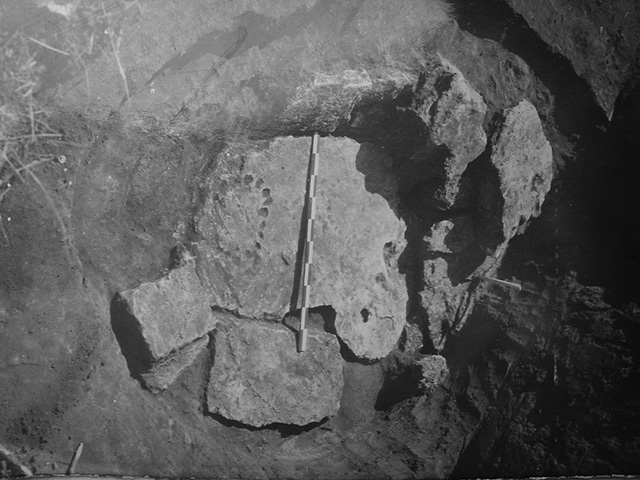| Author | Bronze Age Sundial-Moondial Discovered in Russia |
jackdaw1

Joined:
03-06-2006
Messages: 256
 OFF-Line OFF-Line
|  Posted 19-10-2014 at 14:47 Posted 19-10-2014 at 14:47
Illuminating! Ancient Slab May Be Sundial-Moondial

A strange slab of rock discovered in Russia more than 20 years ago appears to be a combination sundial and moondial from the Bronze Age, a new study finds.
The slab is marked with round divots arranged in a circle, and an astronomical analysis suggests that these markings coincide with heavenly events, including sunrises and moonrises.
The sundial might be "evidence of attempts of ancient researchers to understand patterns of apparent motion of luminaries and the nature of time," study researcher Larisa Vodolazhskaya of the Archaeoastronomical Research Center at Southern Federal University in Russia told Live Science in an email.
Ancient instrument
Last year, Vodolazhskaya and her colleagues analyzed a different Bronze Age sundial, this one found in Ukraine, and discovered it to be a sophisticated instrument for measuring the hours. The work caught the eye of archaeologists in Rostov, Russia, who knew of a similar-looking artifact found in that area in 1991. That slab had been sitting in a museum in Rostov ever since its discovery, and had never been thoroughly studied.
Rostov slab moondial, sundial...
More on top link courtesy of "Live Science" website.
 Profile Profile
 Reply Reply
|
Andy B

Joined:
13-02-2001
Messages: 12290
from Surrey, UK
 OFF-Line OFF-Line
|  Posted 20-10-2014 at 20:14 Posted 20-10-2014 at 20:14
Thanks - the usual predictable question from me  - do we know where this site is? Or the one in Ukraine referred to... - do we know where this site is? Or the one in Ukraine referred to...
 Profile Profile
 Email Email
 Reply Reply
|
jackdaw1

Joined:
03-06-2006
Messages: 256
 OFF-Line OFF-Line
|  Posted 21-10-2014 at 12:22 Posted 21-10-2014 at 12:22
Unsure of the exact locale Andy.
I just try and post these snippets now and again, then hopefully other members usually clarify later.
 Profile Profile
 Reply Reply
|
Runemage

Joined:
15-07-2005
Messages: 3925
from UK
 OFF-Line OFF-Line
|  Posted 21-10-2014 at 15:50 Posted 21-10-2014 at 15:50
This is as close as I can get to a location, Rostov region Russia, Kurgan field Tavriya-1 burials 1 and 2.
Ancient astronomical instrument from Srubna burial of kurgan field Tavriya-1 (Rostov Region, Russia) (Northern Black Sea Coast)
The 'wells' they refer to are the man made indentations in the rock, they are not smooth and round like the cup-marks we are used to seeing.
http://arxiv.org/abs/1410.0675
Larisa Vodolazhskaya, Pavel Larenok, Mikhail Nevskiy(Submitted on 2 Oct 2014)
The article presents the results of analysis of the spatial arrangement of the wells on the unique slab from Srubna burial of kurgan field Tavriya-1 (Rostov region, Russia) by astronomical methods. At the slab revealed two interrelated groups of wells, one of which - in the form of a circle, is proposed to interpret how analemmatic sundial, and second group, consisting of disparate wells, as auxiliary astronomical markers of rising luminaries directions, to correct the position of the gnomon. Simultaneous location of both groups of wells on the same slab is a possible indication of one of the stages of development of the design features analemmatic sundial - setting movable gnomon and technology of measuring time with it. It may point to local origin, as the very idea of analemmatic sundial as well technology measurement of time with them. The article also describes the model analemmatic sundial, hour marks which in many cases coincide with the wells arranged in a circle, particularly in a working range from 6 to 18 hours. In the study proposed a method which can identify moments of solstices and equinoxes in ancient times with the help of the gnomon of analemmatic sundial and mobile gnomons, installed in wells belonging to the second group. The opportunity of use analemmatic sundial as moondial in a full moon night. Slab with two groups of wells is proposed to consider, as the oldest astronomical instrument discovered in the Northern Black Sea coast, which allowed to observe the apparent motion of the Sun and the Moon and allowed measure the time during the day, using analemmatic sundial and at night during the full Moon - with the help of moondial.
All of the astronomical data is in this pdf file, http://arxiv.org/ftp/arxiv/papers/1410/1410.0675.pdf
 Profile Profile
 Reply Reply
|
Runemage

Joined:
15-07-2005
Messages: 3925
from UK
 OFF-Line OFF-Line
|  Posted 21-10-2014 at 16:29 Posted 21-10-2014 at 16:29
Ukranian slab, closest location description I've found so far :-
"The slab was first found in 2011 by a team of archaeologists from the Donetsk Museum of Regional Studies.
Yurii Polidovich and his team were excavating a Bronze Age burial mound between the Ural Mountains and Ukraine's Dneiper River.
Photos of the plate were sent to Vodolazhskaya from the Southern Federal University who confirmed what it was, and what it may have been used for.
She concluded it was a sundial after studying the the size and geometry of the stone and the position of its carvings."
rest of article and some fabulous images http://www.dailymail.co.uk/sciencetech/article-2454533/Ukrainian-Bronze-Age-stone-revealed-oldest-sundial--mark-location-sacrificial-grave.html
null
 Profile Profile
 Reply Reply
|
|







